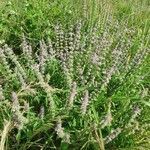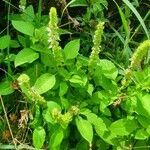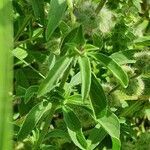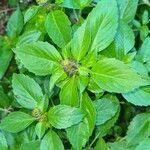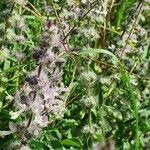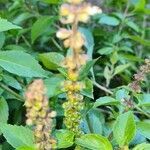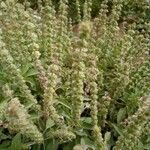| Therapeutic use
|
Anti-bacterial agents (aerial part), Anticoagulants (aerial part), Antifungal agents (aerial part), Malaria (aerial part), Malaria (bark), Anticonvulsants (flower), Antipyretics (flower), Antitussive agents (flower), Common cold (flower), Expectorants (flower), Lice infestations (flower), Nausea (flower), Parasympatholytics (flower), Scabies (flower), Skin diseases (flower), Analgesics (leaf), Anorexia (leaf), Anthelmintics (leaf), Anti-bacterial agents (leaf), Anticonvulsants (leaf), Antifungal agents (leaf), Antioxidants (leaf), Antiparasitic agents (leaf), Antipruritics (leaf), Antipyretics (leaf), Antitussive agents (leaf), Antiviral agents (leaf), Appetite stimulants (leaf), Asthma (leaf), Bites and stings (leaf), Bronchitis (leaf), Cardiotonic agents (leaf), Cholera (leaf), Common cold (leaf), Conjunctivitis (leaf), Contraceptive agents (leaf), Diabetes mellitus (leaf), Diarrhea (leaf), Digestive system diseases (leaf), Diuretics (leaf), Dysentery (leaf), Dyspepsia (leaf), Ear diseases (leaf), Earache (leaf), Exanthema (leaf), Expectorants (leaf), Fever (leaf), Flatulence (leaf), Furunculosis (leaf), Gastrointestinal diseases (leaf), Hearing disorders (leaf), Helminthiasis (leaf), Hemoptysis (leaf), Hemorrhoids (leaf), Hyperglycemia (leaf), Hysteria (leaf), Infection (leaf), Inflammation (leaf), Insect bites and stings (leaf), Insect repellents (leaf), Laxatives (leaf), Leprosy (leaf), Lice infestations (leaf), Lipid peroxidation (leaf), Malaria (leaf), Migraine disorders (leaf), Parasympatholytics (leaf), Anti-poisoning (leaf), General tonic for rejuvenation (leaf), Scabies (leaf), Scorpion stings (leaf), Skin diseases (leaf), Skin diseases, infectious (leaf), Stomach diseases (leaf), Stomatitis, aphthous (leaf), Taste disorders (leaf), Toothache (leaf), Urination disorders (leaf), Vomiting (leaf), Wound healing (leaf), Cooling effect on body (leaf), Diarrhea (rhizome), Antipyretics (root), Antitussive agents (root), Appetite stimulants (root), Bites and stings (root), Common cold (root), Diarrhea (root), Dyspepsia (root), Gastrointestinal diseases (root), Jaundice (root), Parasympatholytics (root), Snake bites (root), Amenorrhea (seed), Antipyretics (seed), Antirheumatic agents (seed), Aphrodisiacs (seed), Asthma (seed), Chest pain (seed), Common cold (seed), Contraceptive agents (seed), Diabetes mellitus (seed), Diarrhea (seed), Emaciation (seed), Expectorants (seed), Eye drops (seed), Hemostasis (seed), Hypoglycemic agents (seed), Inflammation (seed), Jaundice (seed), Leprosy (seed), Leukorrhea (seed), Lung diseases (seed), Malaria (seed), Migraine disorders (seed), Parasympatholytics (seed), General tonic for rejuvenation (seed), Skin diseases (seed), Skin diseases, infectious (seed), Thirst (seed), Urinary tract infections (seed), Urination disorders (seed), Urologic diseases (seed), Vitiligo (seed), Cooling effect on body (seed), Antipyretics (shoot), Digestive system diseases (shoot), Expectorants (shoot), Insect repellents (shoot), Parasympatholytics (shoot), Pharyngitis (shoot), General tonic for rejuvenation (shoot), Antitussive agents (stem), Diarrhea (stem), Insect repellents (stem), Lung diseases (stem), Bite(Dog) (unspecified), Bite(Snake) (unspecified), Catarrh (unspecified), Cholera (unspecified), Convulsion (unspecified), Dysentery (unspecified), Parasiticide (unspecified), Rabies (unspecified), Skin (unspecified), Ardor (unspecified), Cough (unspecified), Spasm (unspecified), Headache (unspecified), Fever (unspecified), Bronchitis (unspecified), Carminative (unspecified), Cold (unspecified), Diarrhea (unspecified), Diuretic (unspecified), Dyspepsia (unspecified), Inhalant (unspecified), Repellant(Insect) (unspecified), Stimulant (unspecified), Stomach (unspecified), Toothache (unspecified), Tuberculosis (unspecified), Tumor (unspecified), Diaphoretic (unspecified), Antiseptic (unspecified), Bactericide (unspecified), Refrigerant (unspecified), Respiratory (unspecified), Tonic (unspecified), Analgesics (unspecified), Anti-bacterial agents (unspecified), Anticoagulants (unspecified), Anticonvulsants (unspecified), Antioxidants (unspecified), Antipyretics (unspecified), Antitussive agents (unspecified), Bites and stings (unspecified), Bronchial diseases (unspecified), Common cold (unspecified), Diabetes mellitus (unspecified), Diuretics (unspecified), Flatulence (unspecified), Insect repellents (unspecified), Jaundice (unspecified), Lice infestations (unspecified), Mouthwashes (unspecified), Muscle cramp (unspecified), Parasympatholytics (unspecified), Pharyngitis (unspecified), General tonic for rejuvenation (unspecified), Skin diseases (unspecified), Snake bites (unspecified), Wound healing (unspecified), Antifungal agents (whole plant), Antinematodal agents (whole plant), Antipyretics (whole plant), Bronchitis (whole plant), Common cold (whole plant), Condiments (whole plant), Dyspepsia (whole plant), Flatulence (whole plant), Hypoglycemic agents (whole plant), Leukorrhea (whole plant), General tonic for rejuvenation (whole plant), Skin diseases (whole plant), Urogenital system (whole plant), Diaphoretic (whole plant)
|

